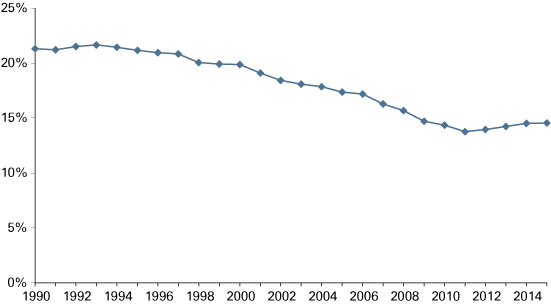Evansville Forecast 2016
Professor of Economics and Dean of Business, Romain College of Business, University of Southern Indiana
The conversion of economic data resulting from changes to the metropolitan statistical area delineations took effect in 2015. This change, based on data from the 2010 Census and officially delineated by the U.S. Office of Management and Budget (OMB) in 2013, resulted in the number of counties in the Evansville MSA dropping from six to four. Gibson County in Indiana and Webster County in Kentucky are no longer included in the Evansville Metropolitan Statistical Area. The analysis and projections in this article are based on historical and current socioeconomic data for Posey, Vanderburgh, and Warrick counties in Indiana and Henderson County in Kentucky.
During 2015, relatively strong growth in manufacturing and retail trade, combined with increases in personal income and announcements of future fixed investments, provide the basis for projecting increased output, income and employment in 2016.
Nominal personal income is estimated to have increased by 4.1 percent and real gross metro product is estimated to have increased by 1.7 percent in 2015 (once all data are released). In 2016, Evansville metro area output is forecasted to increase by 2.5 percent, the number of jobs is projected to increase by 2,500, nominal personal income growth is forecasted to increase by 4.4 percent, and the unemployment rate is projected to be 4.3 percent.
The unemployment rate in the Evansville metro fell from 5.3 percent in January 2015, to 4.0 percent in September 2015, compared with a drop in the national unemployment rate from 6.1 percent to 4.9 percent over the same time period. Job gains occurred primarily in the following sectors: professional and business services, construction, manufacturing, and retail trade. The primary activities experiencing jobs losses were in the information and other services sectors.
On average, homeowners experienced a slight decline in existing home prices from an average of $145,953 to $145,228 in 2015. Between 2014 and 2015, single-family housing permits are estimated to have increased by 23.6 percent, while housing starts increased from 725 to 765.
The manufacturing sector continues to be important to metro area household incomes and consumer spending activity—even as the economy exhibits a long-term pattern of diversification away from manufacturing-industry dependence (see Figure 1).
Figure 1: Evansville Metro Manufacturing Employment as a Percent of Total Nonfarm Employment

Source: STATS Indiana, using U.S. Bureau of Labor Statistics and Indiana Department of Workforce Development data
As one of the most manufacturing-dependent metro areas in the nation, the Evansville economy was noticeably impacted by the recent recession. Since 2007, Evansville’s manufacturing workforce has fallen by 8.2 percent or about 1,100 workers, compared to the 5.1 percent reduction in Indiana’s manufacturing workforce over the same period. In 2015, manufacturing earnings continue to be a significant driver of economic activity, accounting for about 27 percent of total earnings in the Evansville economy. As Table 1 shows, the manufacturing sector accounts for 14.5 percent of employment in the Evansville metro.
Table 1: Manufacturing’s Percent of Total Employment, September 2015
| Evansville Metro | U.S. | Indiana | |
|---|---|---|---|
| Manufacturing | 14.5% | 8.7% | 17.2% |
| Durables | 38.9% | 63.1% | 72.3% |
| Nondurables | 61.1% | 36.9% | 27.7% |
Source: STATS Indiana, using U.S. Bureau of Labor Statistics and Indiana Department of Workforce Development data
Given the proportion of output that is sold outside of the metro area, the strength of the recovery in the Evansville area is linked to the strength of the broader economy. As employment and demand for locally produced goods continue to surpass prerecession levels, disposable income and output growth are expected to increase in 2016.
A widening gap between the Evansville economy and the U.S. economy with regard to income growth over the past three decades highlights the importance of achieving higher rates of future output and employment growth. The expected completion of the I-69 segment between Evansville and Bloomington by the end of 2015 will be an important source of expanded economic activity. The additional transportation and distribution networks resulting from the I-69 extension are expected to provide a solid foundation for long-term employment and output growth.




